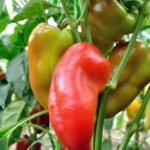Are you wondering what drip to use vegetable gardens? Drip irrigation is an essential tool for maintaining a healthy and thriving vegetable garden. In this article, we will explore the different types of drip irrigation systems, the benefits of using drip irrigation in vegetable gardens, and how to choose, install, manage, and maintain a drip irrigation system. We will also cover common mistakes to avoid and provide tips for maximizing the effectiveness of drip irrigation in your vegetable garden.
Drip irrigation is a method of delivering water directly to the base of plants through a network of tubing and emitters. This efficient watering technique ensures that plants receive a consistent supply of water while minimizing waste and reducing the risk of diseases caused by overwatering. Whether you are growing tomatoes, peppers, lettuce, or any other vegetables, implementing a drip irrigation system can significantly improve the health and productivity of your garden.
In the following sections, we will delve into the specifics of different types of drip irrigation systems, the advantages they offer, and how to effectively implement them in your vegetable garden. Understanding these key concepts will enable you to make informed decisions about which system is best suited for your garden’s unique needs.
Understanding the Types of Drip Irrigation Systems
When it comes to choosing the right drip irrigation system for your vegetable garden, it’s important to understand the different types available. Each type has its own unique features and benefits, so knowing the options will help you make an informed decision.
Drip Tape Systems
Drip tape systems are a popular choice for vegetable gardens due to their affordability and ease of use. They consist of thin plastic tubing with evenly spaced drip emitters that deliver water directly to the base of plants. Drip tape systems are ideal for row crops and can be easily moved or adjusted as needed.
Dripline Systems
Dripline systems, also known as inline drip systems, feature tubing with built-in emitters that release water along the entire length of the line. This type of system is great for use in raised beds or around individual plants, delivering water precisely where it’s needed.
Micro Sprinklers
Micro sprinklers are another option for vegetable gardens, providing a gentle spray of water over a larger area. They are often used in combination with drip irrigation to ensure thorough coverage, making them suitable for gardens with a variety of plant sizes and spacing.
Understanding the differences between these types of drip irrigation systems will help you choose the best option for your vegetable garden. Consider factors such as the layout of your garden, the types of vegetables you’re growing, and your specific watering needs when making your selection.
Benefits of Using Drip Irrigation in Vegetable Gardens
Water Conservation
One of the key benefits of using drip irrigation in vegetable gardens is water conservation. Traditional methods of watering, such as sprinklers or hand watering, can lead to water wastage due to evaporation and runoff.
Drip irrigation systems deliver water directly to the roots of plants, minimizing water loss and ensuring that plants receive the necessary moisture for healthy growth. This not only conserves water but also helps lower water bills, making drip irrigation an environmentally friendly and cost-effective option for vegetable gardeners.
Weed Control and Disease Prevention
Drip irrigation also offers the benefit of reducing weed growth and preventing diseases in vegetable gardens. By delivering water directly to the base of plants, drip systems reduce moisture on the soil surface, which can inhibit weed germination. Additionally, since the foliage remains dry with drip irrigation, there is a lower risk of fungal diseases spreading among the plants compared to overhead watering methods. This can result in healthier plants and easier maintenance for vegetable gardeners.
Fertilizer Efficiency
Another advantage of using drip irrigation in vegetable gardens is its ability to improve fertilizer efficiency. With traditional watering methods, fertilizers may be washed away from plant roots or distributed unevenly across the garden.
Drip systems can be integrated with fertilizer injection systems to deliver nutrients directly to the root zone of plants, ensuring that they are efficiently absorbed for optimal growth. This not only maximizes the effectiveness of fertilizers but also reduces the overall amount needed for vegetable garden maintenance.
Choosing the Right Drip Irrigation System for Your Vegetable Garden
When it comes to choosing the right drip irrigation system for your vegetable garden, it’s important to consider a few key factors. The first step is to assess the size of your garden and the specific watering needs of your vegetables. Different drip irrigation systems have varying capacities and water flow rates, so it’s crucial to select one that can adequately cover the entire garden area and deliver the necessary amount of water.
Another important consideration is the type of soil in your vegetable garden. The soil composition can impact how water is distributed, so it’s essential to choose a drip irrigation system that can effectively penetrate and hydrate the soil. For example, if you have dense or compacted soil, a drip irrigation system with adjustable emitters or bubblers may be more suitable as they can help disperse water more evenly.
Additionally, take into account the topography of your vegetable garden. If you have sloped or uneven terrain, a pressure-compensating drip irrigation system may be more appropriate as it can regulate water flow and ensure consistent watering across different elevations. On the other hand, if your garden has a flat surface, a standard drip irrigation system may suffice.
Once you’ve considered these factors, you can then explore different types of drip irrigation systems such as traditional inline drip tubing, emitter tubing, or micro-sprinklers. Each type has its own advantages and limitations, so it’s important to weigh them against your specific gardening needs before making a decision.
| Key Factors | Considerations |
|---|---|
| Garden Size and Water Needs | Assess size and watering requirements |
| Soil Type | Consider soil composition for effective water penetration |
| Topography | Take into account sloped or flat terrain when choosing system type |
| Different Types of Drip Irrigation Systems |
How to Install a Drip Irrigation System in Your Vegetable Garden
Installing a drip irrigation system in your vegetable garden is a relatively simple process that can yield great rewards. To begin, you will need to gather all the necessary materials, including drip tubing, emitters, connectors, and a pressure regulator. Once you have the materials, it is important to create a detailed plan for the layout of your irrigation system. This will help ensure adequate coverage for all of your vegetables.
Next, you will need to prepare the area by clearing any debris and ensuring that the soil is properly tilled. This will make it easier to lay down the tubing and emitters. The main line tubing should be laid out first, followed by the placement of emitters near each plant. It is essential to secure the tubing in place using stakes or other fasteners to prevent movement.
Once the layout is complete, it is time to connect your irrigation system to a water source. This may involve attaching a hose or pipe to your main water supply and installing a filter and pressure regulator if necessary.
After testing the system for leaks and adjusting the water flow as needed, you can cover the tubing with mulch or other protective material to prevent damage from sunlight or animals. With these steps completed, your vegetable garden should now be equipped with an efficient and effective drip irrigation system for optimal growth and yield.
Managing and Maintaining Your Drip Irrigation System
Once you have installed a drip irrigation system in your vegetable garden, it is important to properly manage and maintain it to ensure the best results. Proper management and maintenance will help prevent clogging, leaking, and other issues that can affect the efficiency of the system.
Here are some tips for managing and maintaining your drip irrigation system:
- Regular Inspection: It is important to regularly inspect your drip irrigation system for any signs of damage, clogging, or leaking. This will help you identify and address any issues before they become major problems.
- Clearing Filters: Most drip irrigation systems have filters to prevent clogging. These filters should be checked and cleared regularly to ensure that water flow is not obstructed by debris or sediment.
- Check for Leaks: Inspect all connections, hoses, and emitters for any leaks. Even small leaks can lead to water wastage and reduce the effectiveness of your irrigation system.
In addition to these tips, it is important to follow the manufacturer’s instructions for maintaining your specific type of drip irrigation system. Proper management and maintenance will ensure that your drip irrigation system continues to provide efficient water delivery to your vegetable garden.
Common Mistakes to Avoid When Using Drip Irrigation in Vegetable Gardens
When it comes to using drip irrigation in vegetable gardens, there are some common mistakes that gardeners should be aware of and avoid. One of the most common mistakes is improper installation, which can lead to uneven watering and inefficient use of water. It’s important to take the time to properly install the drip irrigation system, including ensuring that the lines are buried at the appropriate depth and that the emitters are placed close enough to each plant.
Another mistake to avoid is using the wrong type of drip irrigation system for your vegetable garden. There are various types of systems available, such as soaker hoses, emitter tubing, and micro-sprinklers, each with their own advantages and disadvantages. It’s essential to choose the right system based on factors like the size of your garden, water pressure, and specific watering needs of your vegetables.
One more common mistake is failing to monitor and maintain the drip irrigation system regularly. Over time, clogs can develop in the emitters or lines, which can lead to uneven watering or complete blockage. Additionally, it’s important to adjust the system as needed based on changes in weather and plant growth. By regularly monitoring and maintaining your drip irrigation system, you can ensure that it continues to effectively provide water to your vegetable garden.
| Common Mistakes | How to Avoid |
|---|---|
| Improper installation | Take time for proper installation; bury lines at appropriate depth; place emitters close enough |
| Using wrong type of system | Consider factors like garden size and water pressure; choose appropriate system based on watering needs |
| Failing to monitor & maintain | Regularly check for clogs; adjust system based on weather & plant growth |
Tips for Maximizing the Effectiveness of Drip Irrigation in Vegetable Gardens
One of the main advantages of using drip irrigation in vegetable gardens is the ability to maximize its effectiveness. Here are some tips for getting the most out of your drip irrigation system:
- Proper Placement: Ensure that your drip emitters are placed strategically around each plant to deliver water directly to the root zone. This will prevent water wastage and ensure that each plant receives adequate moisture.
- Regular Maintenance: Inspect and clean your drip irrigation system regularly to prevent clogs and blockages. Check for leaky connections or damaged tubing, and replace any faulty components to maintain efficient water flow.
- Adjust Watering Schedule: Be mindful of the specific watering needs of different vegetables in your garden. Adjust the frequency and duration of watering based on factors such as soil type, weather conditions, and plant growth stage.
In addition to these tips, it’s important to consider investing in a quality drip irrigation system that offers features such as adjustable water pressure, filtration systems, and programmable timers. By maximizing the effectiveness of your drip irrigation system, you can promote healthy plant growth, conserve water, and achieve higher yields in your vegetable garden.
Ultimately, implementing these tips can lead to significant savings in water usage while promoting optimal growing conditions for your vegetable crops. With careful planning and regular maintenance, a well-designed drip irrigation system can be a valuable asset for any vegetable garden.
Conclusion
In conclusion, the use of drip irrigation in vegetable gardens is incredibly beneficial and shows great promise for the future of sustainable gardening practices. The ability to control the amount and frequency of water delivery directly to the root zone of plants not only conserves water but also promotes healthier plant growth and higher yields. As the demand for efficient and environmentally friendly agricultural practices continues to grow, drip irrigation will likely become even more popular among vegetable gardeners.
It is important for gardeners to carefully consider the types of drip irrigation systems available and choose one that best suits their specific needs. Whether it’s a soaker hose system, emitter tubing, or a micro-sprinkler system, understanding the benefits and limitations of each type can help maximize the effectiveness of water delivery in vegetable gardens. Additionally, proper installation, maintenance, and management of a drip irrigation system are crucial for its long-term success.
As technology advances and more sustainable solutions are sought after in agriculture, there may be further developments in drip irrigation specifically tailored to the needs of vegetable gardens. With improved water conservation practices and increased crop productivity as primary goals in gardening, it is likely that drip irrigation will play an increasingly significant role in shaping the future of vegetable gardening.
By staying informed about new innovations and remaining dedicated to sustainable gardening methods, vegetable gardeners can look forward to continued success with drip irrigation systems in the years to come.
Frequently Asked Questions
What Size Drip Emitters to Use for Vegetables?
When choosing the size of drip emitters for vegetables, it’s important to consider the water needs of the specific vegetables being grown. Generally, 1 gallon per hour (GPH) drip emitters are a good choice for most vegetable plants.
However, for larger plants or those with higher water needs, such as tomatoes or squash, 2 GPH emitters might be more appropriate. It’s best to assess the individual water requirements of each vegetable and adjust the emitter size accordingly.
What Is the Best Water for Vegetable Gardens?
The best water for vegetable gardens is typically a balanced and pH-neutral water source. This means that rainwater or properly filtered city water can both be good choices.
It’s important to avoid using heavily chlorinated or salty water, as this can harm the plants over time. Additionally, irrigation with recycled greywater should be avoided in edible gardens due to potential health risks associated with contaminants.
What Is the Best Drip System for Tomatoes?
The best drip system for tomatoes is one that provides consistent and even moisture to the plants’ root systems while keeping foliage dry to prevent disease. A soaker hose or adjustable drip emitters placed near the base of each tomato plant works well to achieve this goal.
It’s also important to monitor the soil moisture regularly and adjust the drip system as needed based on weather conditions and plant growth stages. Remember that watering needs may change during different growth stages of tomatoes, so flexibility in your drip system is key for optimal tomato production.

If you’re looking to get into vegetable gardening, or are just looking for some tips on how to make your current garden better, then you’ve come to the right place! My name is Ethel and I have been gardening for years. In this blog, I’m going to share with you some of my best tips on how to create a successful vegetable garden.





